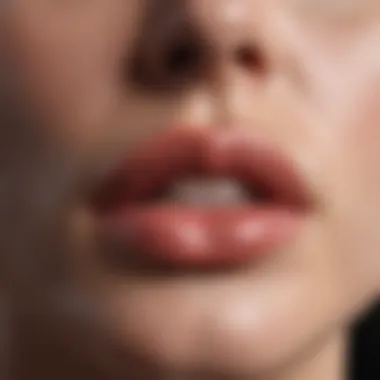Effective Strategies to Relieve Chapped Lips Naturally


Intro
Chapped lips are more than a cosmetic issue; they reflect a combination of environmental factors and personal routines. The skin on lips is thinner and more sensitive than on other body parts, making it particularly vulnerable. Factors like dry air, cold weather, excessive sun exposure, and dehydration can all contribute to this uncomfortable condition. Understanding the reasons behind chapped lips is the first step towards effective relief.
This section provides real tailored strategies while also emphasizing practical knowledge. Protecting lip health is crucial for overall well-being. The subsequent passages will detail methods ranging from natural remedies to specific cosmetic products designed not just to maintain but to enhance lip health. It’s important to explore personalized approaches, acknowledging that each individual has unique needs.
Adopting practices may lead to improved outcomes. Whether one aims for immediate relief or long-term prevention, awareness is key. Beginning with manageable interventions, anyone can navigate through to sustained lip health with effective methods.
Fashion Trends
Fashion does not exist in isolation; it deeply intertwines with beauty and skincare. Chapped lips screened by stylish outfits can sabotage overall aesthetics. Therefore, choosing to adopt trends that highlight lip health becomes essential.
Runway Highlights
Recent runway shows showcase a spotlight on healthy, vibrant lips. Models flaunt shades that range from nude tones to bold reds. Designers are embracing worn-in looks with faint glossy applications. Thus, there’s a significant push for sparkling but hydrated lips. These looks encourage individuals to pay attention to hydration routines.
Seasonal Must-Haves
The change of season can warrant new approaches. Winter necessitates thicker lick balms, while summer often means lighter formulas with UV protection. Keeping lips moisturized through appropriate products aligns with both seasonal transitions and fashion sensibilities. Selections like eos Organic Lip Balm or Burt's Bees Lip Balm align well, tailored to the varying demands of the seasons.
Celebrity-inspired Looks
Celebrities often set lip trends that followers find with keen interest. Take cues from stars who focus on minimalistic makeup but allow their lip looks to stand out. The strategies can include overlaying moisturizer beneath lipsticks to fend off dryness. Unique combos, such as topping off lipstick with a bursts of gloss, can create options that effectively both nourishing and aesthetically pleasing.
Beauty Tips and Tricks
A few well-structured habits can tame the issue of chapped lips comprehensively. Whether through regular skincare regimens, informed makeup decisions, or diligent nurturance of hair care routines, each component impact lip health.
Skincare Regimens
Routine application of moisturizers provides great benefits. Look for hydrating elements such as shea butter and coconut oil that efficiently facilitate moisture retention. Noting how lip skin responds invites one to innovate based on their own preferences. Vegan and organic options gain traction among environmentally aware users, appealing to a range of beliefs. By choosing a quality occlusive agent, the moisture is locked in beyond just the application.
Makeup Tutorials
Makeup application techniques can aid lip health. Always prep lips by ensuring a primer or base before applying any color. Lightly exfoliating can remove dead cells, leading to a smoother application afterward. Tools like a soft toothbrush or dedicated lip scrub can be effective. Reduction of products exhibiting high shimmer can avoid enhancing dry and chapped areas.
Hair Care Secrets
Customer care for the hair may also reflect on lips. Using overheating tools affects hydration drastically. Lessening exposure to dry air and chemical hair products play roles that people often overlook. Be cautious to discover holistic approaches that ultimately benefit overall skin.
Moving Forward
Through examination and adaptation of your habits, you can effectively confront chapped lips. Prioritize keeping environment moisture-rich while aligning lipknowing trends with personal era.
Deciding what works for you relies heavily on trial and error. It’s suggested to create individual ways to support durable lip vitality. Always remember that professional guidance** is important for anyone reading persisten*t & challenges. Thus, knowing where to seek effective assistance is instrumental for brighter days ahead.
“Healthy habits today lead to satisfying results into the future.”
Understanding Chapped Lips
Chapped lips represent not just a cosmetic issue but also a problem that often indicates broader concerns about hydration, health, and overall skincare routines. Understanding this condition provides a foundation for both prevention and treatment. Adequately addressing chapped lips can boost not only personal comfort but also enhance overall beauty perception. Clear knowledge ensures individuals can make informed decisions regarding proper care and necessary interventions when conditions do not improve.
Defining Chapped Lips
Chapped lips, technically referred to as cheilitis, occur when the lips become dry, cracked, or inflamed. This condition usually leads to physical discomfort and can result in painful fissures, affecting the fabric of everyday life. In understanding chapped lips, it emphasizes that this is often a sign that one's skin is lacking moisture and might signal the body’s need for additional care, particularly concerning hydration.
Common Signs and Symptoms


Signs of chapped lips manifest typically as redness, dryness, and sometimes flaky skin on the lips. When looking closely, individuals may also notice small fissures or cracks appearing, which might become painful or sensitive in response to food, drinks, or even environmental elements. Recognizing these symptoms early can enable prompt action to remedy this issue before it escalates.
Causes of Chapped Lips
Environmental Factors
Environmental elements significantly contribute to chapped lips. Dry air, especially during autumn or winter, removes moisture from the skin layers of lips, causing them to dry out. Sun exposure can also play a role, as ultraviolet rays can be harmful and lead to skin peeling. During cold weather, the lips may lose natural oils rapidly, resulting in sensitivity and pain. Recognizing these factors aids in choosing the right preventive strategies. Consequently, understanding local climate conditions is essential.
Personal Habits
Personal habits often undermine lip health inadvertently. For example, habits such as lip licking or biting can exacerbate dryness, worsening the condition over time. Frequent consumption of certain foods, like salty or spicy snacks, can lead to irritation of existing dryness. Among the habits to evaluate is how often time is spent in heated environments; central heating can excessively dry air, impacting skin hydration. Being aware of these contributions is important to mitigate uncontrolled worsening of dry lips.
Health Conditions
Health issues sometimes provide insight into recurrent chapped lips. Conditions like eczema or psoriasis may manifest through the epidermis of the lips as well. It is prudent to remain informed about potential skin disorders that could cause persistent lip problems. Additionally, conditions impacting bodily hydration like diabetes or thyroid disease should escalate discussions of lip care and attention since they can contribute significantly to skin health. It's essential to recognize if underlying health conditions continuously affect lips.
Allergies and Irritants
Certain allergies and irritants can be contributing moments to chapped lips. Allergic reactions, often from lip products or lipsticks containing fragrances or chemicals, may aggravate or spark breakouts. Other irritants, such as certain ingredients in toothpaste, can lead to swollen, painful lips. Identifying these triggers allows one to eliminate the sensitivity and helps recognize which products are better suited for one’s routine, culminating in healthier-looking lips. Contacting specialists for skin tests sometimes yields fruitful results to denote these allergens or irritants.
Preventive Measures
Preventive measures are crucial in managing chapped lips. Ensuring the health of your lips goes beyond mere cosmetics. It involves adopting habits that can rejuvenate your lips and prevent issues from arising in the first place. By focusing on nature-inspired solutions, personal wellness, and conscious daily routines, one can effectively combat the discomfort associated with chapped lips.
Maintaining Hydration
Hydration plays a pivotal role in lip health. Lips do not possess oil glands like other skin areas, making them susceptible to dehydration. Drinking sufficient water helps maintain moisture levels within the body, translating to hydration for your lips as well. Ingesting beverages that dehydrate, such as coffee and soda, can offset this balance. To counteract these elements, maintain a steady routine of water intake.
Nutrition and Lip Health
Essential Vitamins and Minerals
Vitamins and minerals significantly contribute to lip health. They work by nourishing the skin cells that form the lip barrier. Vitamin E, for instance, acts as an antioxidant, promoting healing and protection from oxidative stress. Vitamin B complex, including B2 and B3, supports skin moisturization and barrier function. These nutrients are not just beneficial but essential for sustaining the softness of the lips.
Foods to Incorporate
Incorporating certain foods in daily meals can markedly improve the condition of your lips. Foods rich in healthy fats provide necessary oils for skin health. Avocados, nuts, and fatty fish are prime examples. Citrus fruits, while refreshing, are also great at offering Vitamin C, which is crucial for collagen production. Whole grains and greens, containing fiber and essential nutrients, additionally support overall skin health, indirectly promoting lip well-being.
Avoiding Lip-Licking and Biting
One of the most detrimental habits to lip integrity is licking or biting lips. Saliva can dry the skin, leading to further chapping. Biting can also induce micro-tears that may become infections and worsen the condition. Encouraging minor practices, like using lip balm frequently or resolving stress through other means, can help reduce this habit. Setting mindful reminders will aid diligently working to break these habitual nuisances.
Remember, consistency is the key when implementing preventive measures for maintaining healthy, supple lips. Whether through hydration, nutrition, or habit modification, every little effort adds to the big picture of lip health.
Home Remedies
Home remedies represent a practical approach to address chapped lips. They emphasize the use of natural ingredients commonly found at home or in the kitchen. These remedies often offer immediate relief and, by sticking with them, become quite effective over time. Their holistic and gentle nature appeals to those looking for non-invasive solutions. Factors like sickness or climate changes can make your lips dry and cracked, and enriching your lifestyle with home remedies can greatly aid in alleviating discomfort.
Natural Oils
Using natural oils has remained a significant strategy in lip care. Oils act as emollients which prevent moisture loss and add hydration. They also provide barriers against environmental stressors. Each oil used has distinct properties making them suitable for specific cases. Here's a closer examination of three popular oils that serve to combat chapped lips.
Coconut Oil
Coconut oil enjoys notable status due to its moisturizing effect. It contains medium-chain fatty acids that function efficiently in lip hydration. An advantage of coconut oil is its quick absorption. Those using it often experience a smooth application without greasiness. Furthermore, coconut oil has antifungal properties that may combat skin infections, adding another layer of benefit.
However, some people report sensitivity to coconut oil. This must be considered when selecting remedies, mainly if you have allergy concerns.
Olive Oil


Olive oil is another ingredient with significant benefits. It acts similarly in the role of moisturizing and protecting the lips. Rich in vitamins E and K, it nourishes the skin cells. Additionally, it has a high level of antioxidants, which can promote healing in cracked areas. Its consistency makes it easy to apply, and its pleasant flavor enhances acceptance in daily use.
On the downside, olive oil can feel somewhat heavier on the lips, which may not suit everyone's preference.
Jojoba Oil
Jojoba oil stands out because of its structure that resembles the natural oils in the skin. This effective resemblance allows it to be easily absorbed, leading to great hydration. It helps to balance the natural moisture levels of the lips.
The versatility of jojoba oil makes it appealing for a variety of skin types. People find it less likely to cause irritation, which is essential for sensitive skin conditions. However, it's worth noting that pure jojoba oil might sometimes be pricier compared to other oils.
Honey and Sugar Scrubs
Honey is well-known as a natural humectant. It pulls moisture into the lips, healing and calming chapped surfaces. When combined with sugar—a gentle exfoliant—it further prevents dryness, promoting a smoother texture. Mixing these elements forms a simple yet effective scrub for daily care. Thanks to the antibacterial nature of honey, this treatment not only soothes but also protects lips.
Aloe Vera Applications
The gel of aloe vera has long been regarded for its healing properties. Applying aloe vera provides a soothing effect which calms irritation. It also promotes faster cell regeneration, majorly benefitting dry or chapped lips. Renewing cellular activity helps create soft and healthy lips. Soothing aloe doesn't just moisturize; it can also aide quick recovery of damaged tissues.
Using these home remedies can play a crucial role in maintaining healthy lips while empowering individuals with natural solutions to healing problems they might regularly face.
Commercial Solutions
Commercial solutions play a crucial role in addressing chapped lips. Unlike temporary fixes that may provide short-term relief, these products are formulated to deliver longer-lasting benefits. They can create protective barriers, optimize hydration, and address the underlying causes of lip dryness effectively. A variety of products are designed specifically to treat chapped lips, making it essential to choose wisely based on ingredients and personal needs.
Choosing the Right Lip Balm
Ingredients to Look For
When selecting a lip balm, one must pay attention to ingredients. The right compnents can vastly improve the effectiveness of the product. Look for hydrating agents such as shea butter, beeswax, and lanolin, which create moisture barriers and prevent water loss. These natural emollients offer superior hydration that is beneficial for individuals suffering from persistent dryness.
Additionally, some balms include sun protection factors (SPF), crucial for shielding lips from UV rays and preventing sunburn, a common cause of lip damage. Balms that have antioxidants can help restore skin, keeping it healthy over time.
Brands to Consider
There are several reputable brands that shine in this space. Brands like Burt's Bees, Carmex, and Aquaphor have received positive feedback for their effective formulations. Each offers unique elements - for instance, Burt's Bees emphasizes natural ingredients and eco-friendly sourcing,
Carmex focuses on providing immediate cooling relief and healing properties, whereas Aquaphor is known for its potent moisturizing capabilities, often recommended for severe chapping. Choosing a reputable brand can give users peace of mind about product quality and effectiveness.
Lip Masks and Treatments
Lip masks and treatments have become increasingly popular. These products are designed to provide intense hydration and nourishment through longer application times. Formulated with concentrated ingredients, they can deliver exceptional moisture and revitalizing benefits. Users often notice improvements in texture and overall lip health with regular usage. Masks will often recommend overnight use for maximum effect, and many contain beneficial ingredients like hyaluronic acid or aloe vera to soothe and repair irritated skin.
Hydrating Serums for Lips
Hydrating serums for lips deserve particular attention as they offer innovative solutions for dry lips. Unlike traditional balms, these products often contain more concentrated hydrators and are lightweight. They penetrate deeply to hydrate and rejuvenate the lip tissue. Some serums feature active ingredients such as vitamin E, known for its powerful antioxidant effects, others may include peptides designed to enhance skin's elasticity reducing the appearance of fine lines. Using lip serums as part of a daily skincare routine helps ensure long-term lip hydration and protection, setting the foundation for lip health.
"The right lip care products are not merely accessories; they reflect personal attentiveness to health and well-being."
Adjusting Your Daily Routine
Adjusting your daily routine plays a pivotal role in managing and preventing chapped lips. The mouth is exposed to various environmental factors daily, making it essential to incorporate effective strategies. Small changes can contribute significantly to lip health. Establishing a consistent routine is beneficial for maintaining moisture levels and protecting the delicate skin of the lips.
Incorporating Regular Exfoliation
Incorporating regular exfoliation in your routine helps in removing dead skin cells from the lips. This process enhances the absorption of lip care products, allowing them to penetrate more effectively. Aim to exfoliate modestly, perhaps once or twice a week.
You can use a simple sugar scrub or a soft toothbrush. The objectives are to promote smoother lips and prevent dryness, making lip care easier. Exfoliation helps in rejuvenating your mouth area and can yield visually pleasing results.


Environmental Protection
Sunscreen for Lips
Sunscreen for lips is crucial to shield against harmful UV rays. Lips often receive less protection compared to the rest of the skin. A lip balm with SPF can significantly decrease sun damage, so look for products that offer this feature.
One key characteristic of sunscreen lip balms is that they guard against both UVA and UVB radiation. This is a beneficial approach for individuals concerned about sun damage. Remember that not all lip products include this vital element.
Key feature: Use a lip product that adds hydration while providing sun protection to combat drying effects of the sun facing factor.
Cold Weather Precautions
Colder weather poses unique challenges to lip health as well. Cold, windy conditions lead to increased moisture loss from the lips. A simple but effective way to ensure they haveg enough protection is to cover the lips when it is cold or windy.
Using a thicker, occlusive lip balm can create a physical barrier. This might include beeswax-based products or other heavy ointments. The goal here is to minimize the moisture loss caused by harsh environments.
The unique feature of this approach focuses on maintaining hydration, especially during dry winter months. If poorly managed, chapped lips can aggravate, leading to discomfort and pain. Adjusting your daily routine with these precautions can help in promoting smoother and more supple lips.
Recognizing When to Seek Help
Identifying when to seek professional assistance for chapped lips is crucial. Many people might dismiss dry lips as a minor issue, but persistent cases can signal underlying health problems. By understanding when to turn to a healthcare expert, individuals can prevent further discomfort or complications.
Persistent Issues
If chapped lips continue despite efforts to relieve them, it's essential to assess whether these issues are persistent. Indicators include excessive peeling, cracks, and pain. Sometimes, these signs may be associated with conditions like eczema or an allergy. If someone encounters ongoing symptoms, consulting a professional can lead to proper diagnosis and treatment. Individuals should keep track of persistent issues, particularly if they are severe or last more than a week, to provide adequate background for a prospective treatment.
Potential Medical Treatments
Potential medical treatments for chapped lips vary widely. Several interventions can assist in alleviating severe symptoms and restoring lip health.
Consulting a Dermatologist
Consulting a dermatologist is a recommended step for dealing with chronic lip issues. Dermatologists specialize in skin, hair, and nails, providing targeted insights into lip skin treatments. Consulting a dermatologist helps patients access tailored solutions, including diagnoses for conditions often misattributed to mere dryness.
Key characteristics that make this approach popular are the ability to receive prescriptions that are more potent than over-the-counter remedies and getting a specialized skin assessment. Unique features of this choice include comprehensive skin evaluations which can present additional systemic health insights.
Advantages include a precise treatment plan that can heal chronic areas effectively. However, drawbacks might include the cost and time which may not suit everyone’s budgets.
Prescription Treatments
Prescription treatments may come into play for severe chapped lips that stubbornly resist typical home remedy approaches and over-the-counter products. Options for types of medications include ointments or creams'. These often feature specific active ingredients, aiming to offer deeper hydration and protect against irritants very effectively.
A beneficial characteristic is the strength and targeted formula, ideal for heavier conditions. This can lead to better individual outcomes. Additionally, unique aspects often include combinations with medicated ingredients that help not just to moisturize but also to protect from further damage.
Yet, individuals must consider a few downsides, such as accessibility of the medications and potential side effects. This may factor when deciding on pursuing this path. Individuals typically benefit from keeping open communication with their healthcare providers, ensuring proper adjustments can happen as needed, depending on treatment progress.
Always prioritize reaching out to a professional if symptoms persist, as chapped lips can sometimes be linked to deeper medical concerns.
In summary, recognizing the right time to get help is crucial. Monitoring symptoms closely and understanding available treatment options would enhance successful strategies in maintaining healthy lips.
End
In addressing chapped lips, the conclusion plays a crucial role in synthesizing the information discussed throughout the article. It emphasizes the importance of combining various strategies to effectively relieve discomfort and prevent future occurrences of chapped lips. This understanding reinforces the significance of a holistic approach—where natural remedies, commercial solutions, and good practices come together to offer optimal care for lip health.
Summarizing Effective Strategies
The array of effective strategies highlighted can be tailored to each individual's needs, uncovering various avenues for relief. Here is a summarization:
- Maintaining hydration, both internally and externally, ensures the lips remain supple.
- Nutrition is key; incorporating essential vitamins, like B vitamins and minerals such as zinc, directly influences skin integrity, including the lips.
- Avoiding harmful habits, such as licking or biting one’s lips, serves only to exacerbate already vulnerable skin.
In terms of products, choosing lip balms with beneficial ingredients like beeswax or shea butter will create protective barriers enhancing hydration. Meanwhile, natural oils prove effective in nourishing the lips without the side effects commonly associated with synthetic substances.
Daily habits surrounding lip care, including exfoliation and protection from harsh environmental factors, further contribute to mouth health. Regular updates—by monitoring any uncomfortable changes—become essential in ensuring that more serious underlying issues are identified and managed promptly.
This concise overview not only reinforces the strategies previously discussed but also highlights that the health of your lips is an ongoing endeavor. With mindfulness and these effective choices, the state of your lips can be significantly improved.















